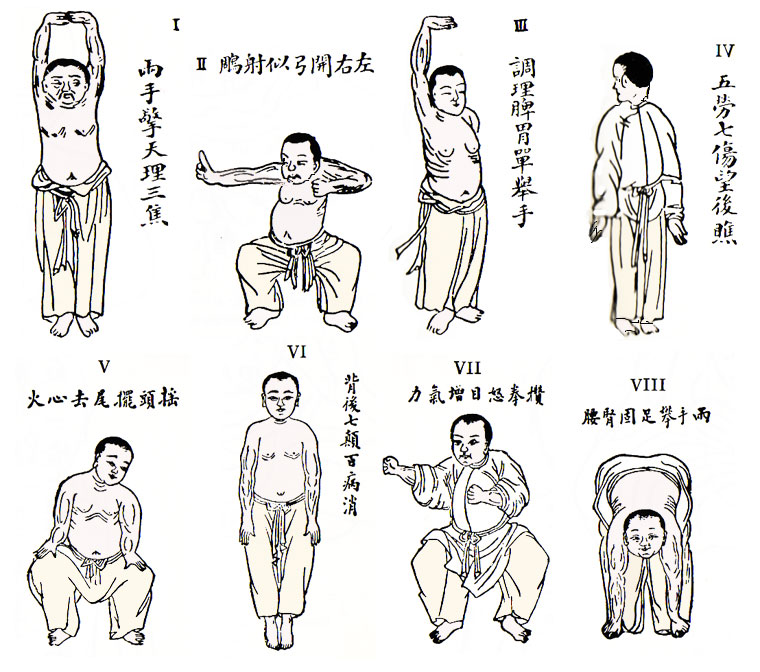八段锦 Baduanjin – Eight Pieces of Brocade
For those of you who wouldn’t be familiar with Qigong, 八段锦 Baduanjin – the Eight Pieces of Brocade in Chinese – is one of the most well-known and practised form of Chinese qigong. The name of this form derives from a metaphor depicting how the eight moves of such a form characterize and wrap the body in a silken-like quality (the likes of a piece of brocade) through its energy.
Dating back as far as the Song dynasty, this series of movements comprises 8 exercises, each focusing on and benefiting a different area of the body – and undoubtedly its corresponding meridians.
It goes like this :

Here is a video of a shaolin version of it:
Description of the moves
1) 双手托天理三焦 (shuang shou tuo tian li sanjiao): Two Hands Hold up the Heavens
This move consists of an upward movement of the hands, from the center of the body to above the head, as if one were holding up the skies. It is said to stimulate the Triple Heater (三焦). Plus, it is quite commonplace to clean and prepare the triple heater before any other move is made indeed.
2) 左右开弓似射雕 (zuoyou kai gong si she diao): Drawing the Bow to Shoot the Hawk
While remaining in the position of the horse stance, also known as 马步 (mabu) in martial arts, the practionner acts as if he were drawing a bow and shooting in both directions (left and right). That move is supposedly good for the waist, the kidneys and the spleen.
3) 调理脾胃须单举 (tiaoli piwei xu dan ju): Separating Heaven and Earth
Strictly speaking, this move doesn’t mean “separating heaven and earth”. I kept it because it is poetic and quite commonplace to refer to it as “the separation of heaven and earth”. Indeed, both hands are separated and should remain horizontal. However, it means “taking care of/healing the spleen and the stomach just by lifting the hand”. I guess you figured what the benefits of such a move are by now, right ?
4) 五劳七伤向后瞧 (wulao qi shang xiang hou qiao): The wise owl gazes backward
This is a stretch of the neck to the left and the right in an alternating fashion. There is no mention of any owl in the Chinese description but I guess the move speaks for itself and resembles an owl that turns its head, hence the mention of the animal. It is said to prevent the ‘5 lesions and 7 injuries’ (五劳七伤), also known in TCM, [ which are said to be caused to the spleen by overeating, to the liver by rage, to the kidneys by lifting heavy weights and sitting too long on wet ground, to the lungs by wearing too little and taking cold food and drinks, to the heart by sorrow and anxiety, to the body by abrupt weather changes, and to the consciousness by immoderate fear]
5) 摇头摆尾去心火 (yao tou bai wei qu xin huo): Sway the Head and Shake the Tail
By rolling the head and shaking the tail, you will get rid of the fire (excessive heat) from your heart. In another horse stance, the practionner places the hands on thighs with the elbows facing out and twists to glance backwards on each side. This move is beneficial for the heart and the lungs.
6) 两手攀足固肾腰 (liangshou pan zu gu shen yao): Two Hands Hold the Feet to Strengthen the Kidneys and Waist
This involves a stretch upwards followed by a forward bend and a holding of the toes. The conduct of the the breath may help out on this one. Personally, it’s one of the moves I enjoy the most.
7) 攒拳怒目增气力 (zan quan numu zeng qili): Clench the Fists and Glare Fiercely
This resembles the second piece as you still have to remain in the horse stance (马步), and consists of a punching movement forward. This, which is the most external of the pieces, is aimed at increasing general vitality and muscular strength. Indeed, when closing your hands after the punch, take time to visualize the energy getting in through your palms.
8) 背后七颠百病消 (beihou qidian baibing xiao): Bouncing on your toes
This is a push upward from the toes with a small rocking motion on landing. The gentle shaking vibrations of this piece is said to “smooth out” the qi after practice of the preceding seven pieces or, in some systems, this is more specifically to follow Sway the Head and Shake the Tail. When you let yourself go and hit the floor, let it go smoothly ! Don’t make it hard and shock your body. You wanna stay quite flexible so the hit doesn’t stiffen you up or hurt you.
🙂 Well, that’s all folks ! You’re done !
Additional video
Don’t you worry if the video above is too martial or extreme for you. You can find plenty of other versions on Youtube. Here is another interesting one though, this time from a Wudang monk.
Have fun and enjoy your practice of 八段锦 Baduanjin – the Eight Pieces of Brocade!
May the Qi be with you… 😉
Posted on December 1, 2020 by Mat.


